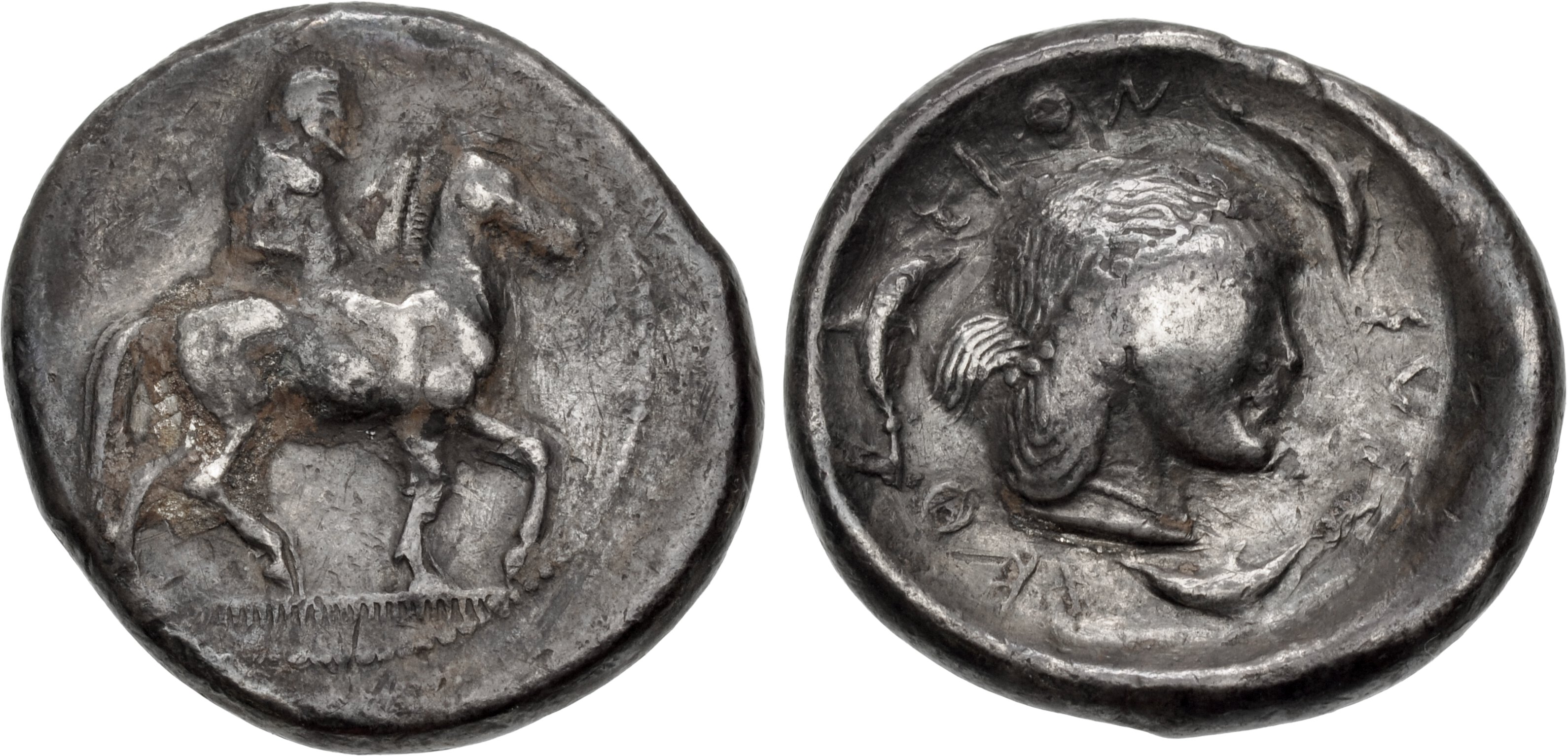Syracuse, silver, didrachms (rider/Arethusa) (478-466 BCE)
From SILVER
485 BCE - 478 BCE Silver 165 kg
Description
| ObverseInscription or printing placed on the obverse.: | Nude horseman riding right |
| ReverseInscription or printing placed on the reverse.: | ΣYPAKOΣION (Greek).Head of Arethusa right, three dolphins around |
Mint and issuing power
| MintIdentifies the place of manufacture or issue of a numismatic object.: | Syracuse | Ancient regionAncient region.: | Sicily | Modern countryModern country: Italy | AuthorityIdentifies the issuing power. The authority can be "pretended" when the name or the portrait of X is on the coin but he/she was not the issuing power. It can also be "uncertain" when there is no mention of X on the coin but he/she was the issuing power according to the historical sources: |
Chronology
| FromIdentifies the initial date in a range assigned in a numismatic context. | 485 BCE | toIdentifies the final date in a range assigned in a numismatic context.. | 478 BCE | PeriodTime period of the numismatic object.: Classical 480-323 BC |
Physical description
| MetalThe physical material (usually metal) from which an object is made.: | Silver |
Median weightMedian of the weights of numismatic objects (in grams). in grams | 8.60 | DenominationTerm indicating the value of a numismatic object. Examples: tetradrachm, chalkous, denarius.: | didrachm |
StandardStandard.: | Attic |
Image

AC 90a - Syracuse, silver, didrachms (485-479 BCE).jpg [1]
References
| Die study referencePublication of the study: | Boehringer 19291Boehringer 1929, p. 131-132, n° 96-101. | ||
| Coin series referenceReference to coin series study: | Sear I2Sear I, n° 915, RQEMAC3RQEMAC, n° 90a, HGC 24HGC 2, n° 1353 | ||
| Coin series web referenceCoin series web references: | |||
Obverse dies distribution
| FrequencyFrequency of specimen in distribution. ᵖ | Number of obversesNumber of obverse dies. ᵖ (o) | % (o) | Number of coinsNumber of coins. (n) | % (n) | Die nameName(s) of the die(s). |
| 35 | 1 | 100 | 35 | 100 | 46 |
| Total | 1 of 1 | 100 | 35 of 35 | 100 |
Reverse dies distribution
no distribution is available
Quantification
| Number of obversesNumber of obverse dies. ᵖ (o) | 1 | Number of singletons (o1)The number of singleton coins. ᵖ | |
| Number of reverse diesNumber of reverse dies. (r) | 6 | Number of coinsNumber of coins. (n) | 35 |
| Coins per obverse dieNumber of coins per obverse die. (n/o) | 35 | Coins per reverse dieNumber of coins per reverse die. (n/r) | 5.83 |
| Reverse per obverse ratioRatio of obverse dies divided by reverse dies. (r/o) | 6 | Percentage of singletons (o1)number of coins (n) divided by the number of singletons (o1) ᵖ | % |
| Original number of dies (O) (Carter 1983 formula)The estimation of the number of coins according to Carter 1983 ᵖ | 0.96 | Coins struck if 20,000 as average productivity per dieCoins made if the average productivity for obverses (according to Carter) is 20,000. ᵖ | 19,200 |
| Original number of dies (O) (Esty 2011 formula)The estimation of the number of coins according to the singleton formula in Esty 2011 ᵖ (O) | 1.03 | Survival rate if 20,000 as average productivity per dieSurvival rate if average productivity is 20,000. ᵖ | 0.00182 |
| Coverage (o = % of O) (Esty 1984 formula)Esty 1984 - coverage (% of O) ᵖ (o = % of O) | % | Die productivity if survival rate 1/2,000Average productivity if survival rate is 1/2,000. ᵖ | 72,916.67 |
| Weight of silver (in kg) if 20,000 coins per die (O = Carter formula)Carter 1983 * Median weight * 20000 (*10 if gold or electrum) ᵖ | 165 kg <br /> 165 kg | Die productivity if survival rate 1/5,000Average productivity if survival rate is 1/5,000. ᵖ | 182,291.67 |
Remarks
Most likely one single workstation
References
- ^ Boehringer, Erich (1929), Die Münzen von Syrakus, Berlin-Leipzig, vi, [2], 297 p. : ill. and portfolio of 32 pl. ; 28 cm
- ^ Sear, David R. (1978), Greek coins and their values. Vol. I, Europe, London, xl, 316 p.
- ^ Callataÿ, François de (2003), Recueil quantitatif des émissions monétaires archaïques et classiques, Numismatique Romaine, Wetteren, VII + 267 p.
- ^ Hoover, Oliver D. (2012), The Handbook of Greek Coinage Series. 2. Handbook of the Coins of Sicily (Including Lipara). Civic, Royal, Siculo-Punic, and Romano-Sicilian Issues. Sixth to First Centuries BC, Lancaster-London, 489 p.